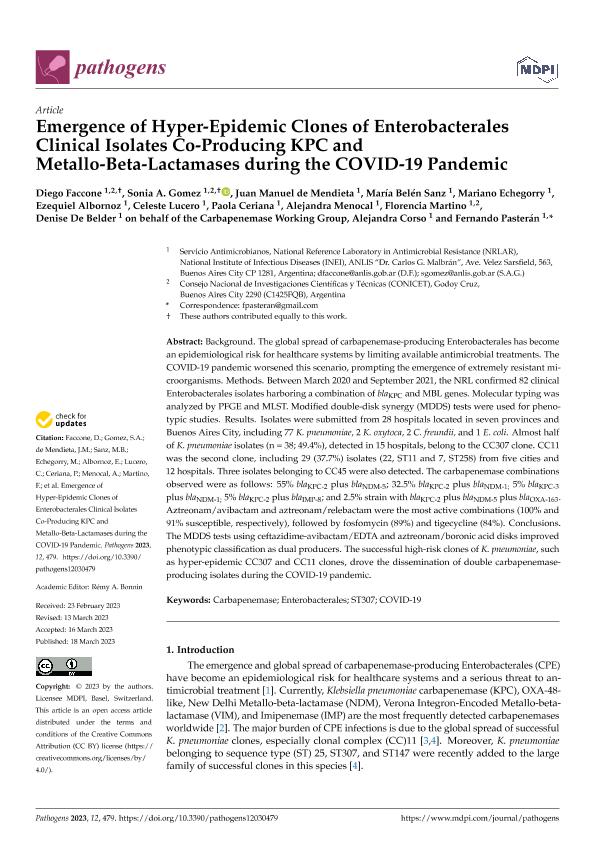Artículo
Emergence of Hyper-Epidemic Clones of Enterobacterales Clinical Isolates Co-Producing KPC and Metallo-Beta-Lactamases during the COVID-19 Pandemic
Faccone, Diego Francisco ; Gómez, Sonia Alejandra
; Gómez, Sonia Alejandra ; de Mendieta, Juan Manuel; Sanz, María Belén; Echegorry, Mariano; Albornoz, Ezequiel Pablo
; de Mendieta, Juan Manuel; Sanz, María Belén; Echegorry, Mariano; Albornoz, Ezequiel Pablo ; Lucero, Celeste; Ceriana, Paola; Menocal, Alejandra; Martino, Florencia
; Lucero, Celeste; Ceriana, Paola; Menocal, Alejandra; Martino, Florencia ; de Belder, Denise Gisele
; de Belder, Denise Gisele ; Corso, Alejandra; Pasteran, Fernando
; Corso, Alejandra; Pasteran, Fernando
 ; Gómez, Sonia Alejandra
; Gómez, Sonia Alejandra ; de Mendieta, Juan Manuel; Sanz, María Belén; Echegorry, Mariano; Albornoz, Ezequiel Pablo
; de Mendieta, Juan Manuel; Sanz, María Belén; Echegorry, Mariano; Albornoz, Ezequiel Pablo ; Lucero, Celeste; Ceriana, Paola; Menocal, Alejandra; Martino, Florencia
; Lucero, Celeste; Ceriana, Paola; Menocal, Alejandra; Martino, Florencia ; de Belder, Denise Gisele
; de Belder, Denise Gisele ; Corso, Alejandra; Pasteran, Fernando
; Corso, Alejandra; Pasteran, Fernando
Fecha de publicación:
03/2023
Editorial:
MDPI
Revista:
Pathogens
ISSN:
2076-0817
Idioma:
Inglés
Tipo de recurso:
Artículo publicado
Clasificación temática:
Resumen
Background. The global spread of carbapenemase-producing Enterobacterales has become an epidemiological risk for healthcare systems by limiting available antimicrobial treatments. The COVID-19 pandemic worsened this scenario, prompting the emergence of extremely resistant microorganisms. Methods. Between March 2020 and September 2021, the NRL confirmed 82 clinical Enterobacterales isolates harboring a combination of blaKPC and MBL genes. Molecular typing was analyzed by PFGE and MLST. Modified double-disk synergy (MDDS) tests were used for phenotypic studies. Results. Isolates were submitted from 28 hospitals located in seven provinces and Buenos Aires City, including 77 K. pneumoniae, 2 K. oxytoca, 2 C. freundii, and 1 E. coli. Almost half of K. pneumoniae isolates (n = 38; 49.4%), detected in 15 hospitals, belong to the CC307 clone. CC11 was the second clone, including 29 (37.7%) isolates (22, ST11 and 7, ST258) from five cities and 12 hospitals. Three isolates belonging to CC45 were also detected. The carbapenemase combinations observed were as follows: 55% blaKPC-2 plus blaNDM-5; 32.5% blaKPC-2 plus blaNDM-1; 5% blaKPC-3 plus blaNDM-1; 5% blaKPC-2 plus blaIMP-8; and 2.5% strain with blaKPC-2 plus blaNDM-5 plus blaOXA-163. Aztreonam/avibactam and aztreonam/relebactam were the most active combinations (100% and 91% susceptible, respectively), followed by fosfomycin (89%) and tigecycline (84%). Conclusions. The MDDS tests using ceftazidime-avibactam/EDTA and aztreonam/boronic acid disks improved phenotypic classification as dual producers. The successful high-risk clones of K. pneumoniae, such as hyper-epidemic CC307 and CC11 clones, drove the dissemination of double carbapenemase-producing isolates during the COVID-19 pandemic.
Palabras clave:
CARBAPENEMASE
,
COVID-19
,
ENTEROBACTERALES
,
ST307
Archivos asociados
Licencia
Identificadores
Colecciones
Articulos(SEDE CENTRAL)
Articulos de SEDE CENTRAL
Articulos de SEDE CENTRAL
Citación
Faccone, Diego Francisco; Gómez, Sonia Alejandra; de Mendieta, Juan Manuel; Sanz, María Belén; Echegorry, Mariano; et al.; Emergence of Hyper-Epidemic Clones of Enterobacterales Clinical Isolates Co-Producing KPC and Metallo-Beta-Lactamases during the COVID-19 Pandemic; MDPI; Pathogens; 12; 3; 3-2023; 1-12
Compartir
Altmétricas



